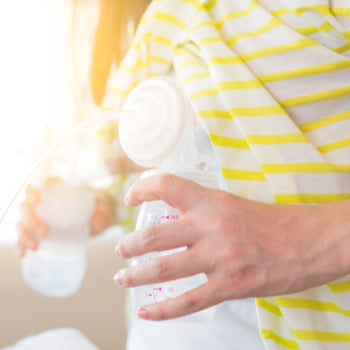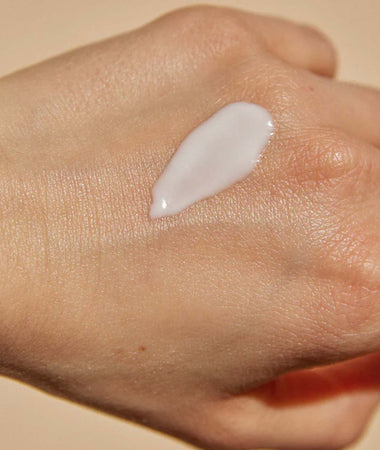
Breast Pumping: A Complete Guide For New Moms
Most new moms eventually need a break from breastfeeding, whether that’s a night out with your friends or significant other, time alone, or just going to work. This is where breast pumping comes in handy!
A breast pump allows you to express and store your breastmilk so your baby can still be fed with that liquid gold when you’re not around. Some moms also choose to exclusively use the breast pump instead of nursing straight from the breast.
Whatever your reason behind breast pumping, Mustela’s baby experts are here to answer all of your questions!
Reasons For Breast Pumping

We understand that sometimes you’re just not able to be with your baby 24 hours a day and breastfeed on demand. That’s OK! There are other options, like breast pumping.
Some reasons you might consider pumping your breast milk include:
- Storing milk for when you’re away from your baby
- Going back to work either part-time or full-time
- Wanting to give your baby breastmilk but not feed directly from your breasts
- Your baby not being able to latch to your breast
- Donating milk
- Increasing or maintaining milk supply
- Relieving engorged breasts
- Expressing milk before nursing
- You or your baby staying in the hospital for an extended time (ex. NICU)
- Other loved ones being able to feed your baby
Before You Start Breast Pumping

First, you’ll need to purchase an electric breast pump before your due date. Most insurance companies provide expecting moms with a free breast pump, so be sure to review your insurance benefits before buying one.
Once you have your breast pump, there are a few things you need to know before beginning to pump.
If you have a healthy, full-term baby, you can wait a few weeks before pumping. However, pumping may help with engorgement during the early days and weeks after giving birth.
If your baby is born prematurely, can’t nurse from your breast yet, or they’re sick, you can start expressing your breast milk within one to six hours after delivery.
Another reason you may begin pumping right after giving birth is if you’ve decided to exclusively pump and not feed directly from your breasts.
Preparing Your Body
Becoming a new mom can take a toll on your body. Throw breastfeeding into the mix and you’ve really got a situation! So before you start breast pumping, take care of (and treat!) your postpartum body.
Try Mustela’s Body Firming Gel to give your skin a firmer look and feel. Bonus: this gel is 100 percent compatible with breastfeeding, making it safe for both you and your little one!
And to ease the discomfort that can easily happen within the first few days (or weeks) of breastfeeding, check out our Nursing Comfort Balm!
This soothing and restorative nipple cream keeps skin comfortable while nursing. The lanolin-free balm moisturizes and protects nipples and helps to replenish and restore skin during and after breastfeeding.
Basics For Breastfeeding And Pumping

Your baby needs both foremilk and hindmilk to be as healthy as possible.
The foremilk is the milk that comes out within the first few minutes of nursing. The hindmilk is the milk that is released at the end of your baby’s feeding session (it’s also where all the good fat is stored, creating those cute little rolls on your baby!).
Your milk supply will change during each growth spurt of your baby’s life, so sometimes you’ll have a lot of milk. This means that it may come out too fast for your baby and they’ll begin coughing.
Sometimes when your milk supply is high, your baby will get full from all the foremilk and will hardly get any hindmilk. Pumping can help you relieve some of your breast milk so your baby can get all the nutrients they need.
Here are a few other things to keep in mind:
- Your milk supply will be best in the morning, making it a prime time to pump.
- Pumping between breastfeeding sessions, either one hour after nursing or one hour before, is ideal.
- Your milk supply will increase the first few weeks of your baby’s life, which is why lactation consultants suggest holding off pumping for the first few weeks. (Your body will create its supply based upon your baby’s demands. Pumping can interfere with that.)
- Expressing your milk at the end of a nursing session with a manual breast pump can help to empty your breasts.
Basics For Exclusively Pumping
If you are exclusively pumping — meaning you’re pumping your breast milk and feeding your baby from a bottle rather than your breasts — pumping 8 to 10 times in a 24-hour period is recommended.
Once your milk production is in full swing, create a pumping schedule during which you can produce anywhere from 25 to 35 ounces of breastmilk in 24 hours.
How To Operate A Breast Pump

If you’re considering an electric breast pump (which we recommend) it’s important to choose a new one so you don’t have to worry about it going out any time soon. Plus, it’s more sanitary to use a new breast pump than a used one.
Before purchasing, be sure to check out reviews on several different pumps to get an idea of what will work best for you.
You can choose a single (one breast at a time) or double (both breasts at the same time) breast pump. A double pump is the most efficient if you’re pumping throughout the day while at work.
No matter which pump you choose, keep these rules in mind:
- Read the breast pump manual in its entirety to learn how to operate your pump.
- Wash your hands with soap and water before pumping.
- Drink a glass of water either right before or during pumping.
- Make sure your pump is assembled correctly.
- Check the battery life on your pump (most pumps today can be charged with a USB cord, so make sure it’s fully charged).
- Store your breast milk in milk storage bags once your pumping session is complete. Write the date and number of ounces on each bag.
- Thoroughly clean your breast pump parts after every use.
Tip: Apply Mustela’s Bust Firming Serum and Stretch Marks Serum as part of your daily routine after pumping in the morning and evening to keep your skin in tip-top shape!
The Bust Firming Serum provides support to your bust area, while the Stretch Marks Recovery Serum is a unique post-pregnancy soothing serum that hydrates your skin to help minimize the appearance of recently formed stretch marks.
And both products are 100 percent safe for breastfeeding babies and moms!
How Much Milk Should I Pump?

We briefly mentioned earlier that you should try to produce 25 to 35 ounces of breastmilk in a 24-hour period. But the exact amount will vary from baby to baby and mom to mom. Don’t get discouraged if you can’t produce this much!
And take into consideration these factors when measuring your milk production:
- Your baby’s age
- Time of day
- Type of pump
- Whether you’re relaxed or stressed
- Amount of time that has passed since you last pumped
Pumping the suggested amount of breast milk probably won’t happen on the first day. But keep up the good work and you’ll soon begin to see your supply increase!
Weaning Off The Breast Pump

Gradually weaning off the breast pump is safe and comfortable. This slower method works best because it gives your body time to adjust to the changes — unlike quitting cold turkey, which could lead to your breasts becoming engorged and possibly infected.
When you’re ready to stop pumping, try one of the two gradual weaning methods below.
Method One:
Drop one pumping session (not the first or last). Let your body adjust to this change, which could take a few days. Then drop one more pumping session at a time until your body completely adjusts.
Continue this process until you’re no longer pumping. The first and last pumping sessions of the day should be the final two you drop.
Method Two:
Keep pumping the same number of times a day, but shorten your pumping sessions.
For example, if you were pumping four ounces of milk, stop pumping when you get three ounces of milk, and so on. Remember to give your body a few days each time to adjust to the change. Repeat until you no longer need to pump.
Tip: If your breasts feel full, pump until you feel comfortable. Letting your breasts stay too full could put you at risk for an infection.
Take Care Of Your Postpartum Body

Whatever your reason for breast pumping, our baby experts support you in your journey! We know how challenging this time can be, but remember that it’s normal for women to experience some skin discomfort and a loss of firmness and elasticity postpartum.
This is why we’ve specially designed products that are guaranteed safe for both you and your baby — like our Body Firming Gel, Stretch Marks Serum, and Stretch Marks Cream — to help restore your postpartum body.
We know you work hard, so we work hard to provide you with information, support, and amazing skin care. So keep at it, mom. Grab your products and start pumping! You and your baby will reap the rewards for years to come.
- reg.
- $28.00
- Sale price
-
$28.00
- reg.
-
reg.
- Unit price
- /per
- reg.
- $16.00
- Sale price
-
$16.00
- reg.
-
reg.
- Unit price
- /per
- reg.
- $23.00
- Sale price
-
$23.00
- reg.
-
reg.
- Unit price
- /per
Suggested Articles

6 Tips For Finding The Best Maternity Clothes

7 Breastfeeding Myths & Realities

The Best Postpartum Care Plan For New Mothers
Get tips, news
and exclusive offers






